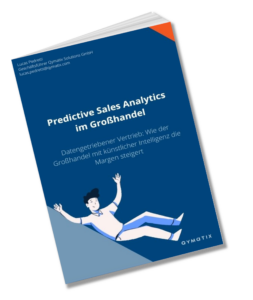The Most Important KPIs in Distribution and the Influence of AI

Please enter your Email address
Key Performance Indicators (KPIs) are also used to manage companies in the retail and wholesale sectors.
AI in the form of predictive analytics can establish correlations between individual KPIs and thus provide recommendations for action.
Numerical parameters are necessary to understand the current situation of a business. Key Performance Indicators (KPIs) are indicators that can be used to measure and determine the performance or degree of fulfilment of pre-defined objectives within a company.
KPIs also help retailers and wholesalers to analyse and monitor essential processes.
Because medium-sized distribution and retail companies, including wholesalers, operate in an increasingly complex and dynamic environment, it is essential to make and implement business decisions quickly. For B2B retailers, it is vital to detect deviations at an early stage and to react to adverse developments in good time. Here, KPIs or key figures are fundamental.
KPIs in the Context of B2B Wholesale Digitisation
The digital transformation does not stop at medium-sized wholesalers either. Sooner or later, it will fundamentally change it. In concrete terms, this involves the digitalisation of procurement, production and distribution processes — a unique challenge for retail companies. Especially in the B2B environment, the multitude of external interfaces to suppliers and customers increases complexity.
Data is, therefore, the basis for successful business decisions.
B2B wholesalers can obtain further information from their KPIs. As mentioned above, this involves the degree to which they attain specific, previously defined objectives. In the typical business conduct of a B2B retail company, data plays a role in many areas: retail companies buy goods, use personnel, premises and marketing instruments to sell the products to customers in the markets and to generate sales and ultimately profits. Each of these processes creates data that they can analyse and control against pre-defined KPIs.
Below are examples of two critical KPIs and their significance in different areas that apply specifically to wholesale companies.
KPIs in the Area of Procurement and Warehousing
Delivery quality
KPI delivery quality is about recording and documenting all errors that occur during delivery or transport to the customer. These are: “Damaged goods”, “Administrative logistics errors”, “Quantity errors” and “Product defects”.
Inventory turnover rate
This KPI deals with the question of how often the warehouse was filled and emptied within a period. The values for the calculation come from the company’s warehouse management system.
KPIs in the Prices and Conditions Area
Bonus ratio
The critical figure bonus ratio expresses how high the share of the total bonus value in gross sales is. Bonuses can be granted to customers, for example, as quantity bonuses, loyalty bonuses, or annual sales bonuses.
Discount rate
This KPI indicates the share of the total value of discounts in gross sales. A high discount rate, like a high bonus rate, can be a sign that it is difficult for the company to sell its products on the market without discounts.
KPIs in the Sales Area
Weighted distribution ratio in wholesale trade
This KPI compares the product group turnover of the outlets selling a given product to the product group turnover of all shops that could actually sell and potentially sell that product.
Distribution channel share
This KPI indicates the ratio of specific distribution channels to total sales. Example: A retail company sells its products via an online shop on one hand, and wholesalers on the other. The sales channel quota can now be calculated from the respective turnover of these two sales channels, measured in terms of total turnover and related to a specific period.
KPIs for Assortments and Locations
Assortment depth
This KPI is the number of product variations within a commodity group offered by an enterprise. One type of wholesale business with a significant assortment depth is considered specialised wholesale. Example: screws wholesale. Here numerous different kinds of screws are offered.
Sales ratio
The sales ratio as a key figure indicates how many parts of an initial inventory were sold within a set time.
KPIs in the Area of Customer Behaviour
Units per purchase
This key figure specifies how many products customers buy per purchase.
Customer churn rate
The churn rate of customers is an important KPI, as a large part of a company’s success depends on recurring payments from existing customers. For forecasting purposes, the churn rate can be used to determine the likelihood of how long new customers will remain loyal to the company.
CALCULATE NOW THE ROI OF QYMATIX PREDICTIVE SALES SOFTWARE
KPIs in the Area of Earnings and Profitability
Cross-selling revenue
The KPI “Cross-Selling Sales” indicates the turnover from the sale of additional products or services to existing customers of a company. Cross-selling in wholesale is used, for example, when the range of the classic product category is no longer enough because the market for the core target group is shrinking.
Customer value
Customer value shows companies how vital and valuable a customer is to them. This KPI enables companies to divide customers into groups and process them in a differentiated manner.
The Most Important KPIs in Distribution and the Influence of AI – Summary
It is becoming increasingly crucial for wholesalers to understand their customers better and react to the analysis data on customer behaviour across all channels. The primary prerequisite for this is a well-founded analysis of your own sales figures.
However, KI’s capabilities go one step further: Predictive Analytics enables a look into the future. This technology finds correlations between past sales figures and makes timely recommendations.
Predictive Analytics software can also derive meaningful, consistent sales forecasts. In B2B wholesale, for example, these insights serve as the basis for location decisions (new openings or closures), for changes in the product mix, for optimising goods management or for tailor-made advertising measures.
Even if people ultimately make their own decisions, AI provides the basis for sound and transparent relationships. The result is recommendations for action that enable wholesale decision-makers to make better decisions.
I WANT TO USE PREDICTIVE ANALYTICS FOR SALES
Free eBook for download: Predictive Analytics in B2B Wholesale
How to start with Predictive Analytics in B2B Wholesale.
Download the free eBook now.
- We will use this data only to contact you for discussing predictive sales KPIs. You can read here our declaration on data protection.

More about Artificial Intelligence in B2B Sales
Sales Management in times of Artificial Intelligence – Five tips to redefine B2B Sales
Artificial intelligence in B2B Sales. New Challenges – New Opportunities.

